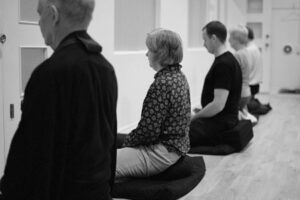
Two recent editorials in the New York Times caught my attention, the first from July 8 entitled “Beyond the Blink” by Frank Partnoy. Its sub-head “A conscious pause can be the antidote to the plague of snap decision making” sounds like an apt description of one of the many side benefits of Zen meditation. The other, from July 22, “Don’t Jump to Conclusions About the Killer” comments knowledgeably about the recent mass shootings in Colorado. Which was the topic of our Dharma dialog that same morning. The author, Dave Cullen, spent ten years studying about, and writing the book, “Columbine.”
Now in Zen, we tend to esteem simplicity. But we do not pretend that reality itself is simple.
zenkai taiun michael elliston, roshi
The connection between the two may be obvious from the titles, but both are worth the read for the way they explore the subject from a serious and considered complexity. In fact, over-simplification is part of the syndrome they are both criticizing.
Now in Zen, we tend to esteem simplicity. But we do not pretend that reality itself is simple.
Zen recognizes, as do the arts and sciences, as well as my former profession, industrial and graphic design, that simplicity is not at all simple. It is exceedingly difficult to achieve. Our return to the cushion is in large part an effort to re-establish simplicity in the midst of our ever-more-complicated lives. Introducing his column, Mr. Partnoy says:
When the Supreme Court announced its decision on the Affordable Care Act last month, the media went wild. The rush to judgment took seconds. The multipart decision is complex, and its ramifications will take months or even years to understand.
After recalling some of the mistaken reporting, he gets to his main thesis:
The blink response to this case is only the latest example of a troubling increase in the speed of our reactions. E-mail, social media and the 24-hour news cycle are informational amphetamines, a cocktail of pills that we pop at an increasingly fast pace — and that lead us to make mistaken split-second decisions.
Then he labels the syndrome with a memorable catchphrase:
Economists label the problem “present bias”: we are vulnerable to fast, salient stimulation.
In Zen, we have a “present bias” that is widely misinterpreted. We practice returning to the present as a method of coping with the tendency of the “monkey mind” to go chasing after daydreams, fretting about the future and ruminating over the past. However, Zen is not simply about blithely “being in the moment.” Zen does not ignore the Three Times, and is highly cognizant of causality throughout all time. But Zen’s causality is not strictly linear, and its time is not a “dimension” like the other three coordinates of the Cartesian concept. Real time is emergent. It arises, abides and decays, along with everything else.
Overweening emphasis on being, and staying, in the present moment is referred to as the “Zen sickness of falling into the moment.” It represents an over-simplistic and self-serving interpretation of Zen Buddhist training and understanding, found in meditation. Mr. Partnoy begins to suggest this when he goes on to say:
Fortunately, there is an antidote: the conscious pause. Scientists have found that although we are prone to snap overreactions, if we take a moment and think about how we are likely to react, we can reduce or even eliminate the negative effects of our quick, hard-wired responses.
Here is something we have seen in our own lives, and which may explain some of the hysterical group behavior we witness from time to time, even in a Zen community. One would think that the “conscious pause” we take on the cushion would have the desired effect upon negative effects (consequences, karmic and otherwise), especially since these pauses can go on for quite some time, and are repeated daily or more frequently.
However, it must be admitted that Zen meditation, while regarded as the most excellent and effective method, is not a panacea. It cannot eradicate these hard-wired responses. Instead, it can allow us to experience them in the safety and sanctuary of the zendo and on the zafu, rather than over-reacting in situ. In this way, we may be able to go beyond simply thinking about how we are likely to react, and come to a point at which we are able to react in an entirely different, and more appropriate, manner. To whatever confronts and confounds us. Including the surprise du jour, Aurora as the latest example.
Our discussion of the Aurora shootings was wide-ranging. It was recorded, as was a talk about earlier shootings in Huntsville. In the near future the file will be posted for review and comment. I kick-started the dialog by suggesting some controversial views that will probably never be aired in the media. Which, I believe, is a big part of the problem of why these atrocities keep happening.
The main point I want to make about this incident is that it should not be a surprise to anyone. That we are not safe anywhere is a basic premise of Buddhism. That our indulging vicarious pleasure in fictional violence as an entertainment is somehow okay, but that real violence is not, is a basic delusion of humanity. It is also an indictment of this co-called democracy. And its representatives.
We are again unwilling witness to the tawdry and grating spectacle of members of Congress pontificating about what we are going to do to prevent this from happening in future. Grandly declaring that it will be a measure of the character of that august deliberative body. All the while the speaker, posturing to be seen at the head of any parade, however grisly, exudes that “character” eloquently, if unbeknownst to himself. The truth is that Congress is going to do nothing to prevent this kind of thing in the future, and everybody knows it, as well that they have done nothing of substance in the past to prevent this kind of thing. The emperor does not have an exclusive on new clothes.
As Buckminster Fuller pointed out, we turn to the politicians for solutions, but if they had any real solutions, they wouldn’t be politicians. They have to pretend to offer solutions, without jeopardizing their constituents’ interests, so that they can get re-elected. The politician’s goal is to maintain status quo, the same as that of ordinary consciousness. Ordinary consciousness keeps a lid on change, imposing what Buddha was said to have described as a “false stillness on reality.” This false perception is our comfort zone, out of which we are rarely shaken. The occasional Aurora or Columbine interrupts the fantasy.
The media predictably rush in to “get the scoop” and “cover the action,” with celebrity anchors and experts elbowing politicians off the stage. However polished and preening, they come off as little more than professional rubberneckers, barkers at the midway freak show. Their dulcet tones barely conceal their relish in serving up such ghoulish fare. Then yet again we hear the call for “closure” and much talk of “healing.”
It is all so predictable. Why does anyone bother to act surprised anymore, let alone shocked or outraged? This is the new societal norm, and it is going to get much worse before it gets better. It is not that nothing can be done; it is that nothing will be done. Too many people are not affected directly, and too many others benefit, directly or indirectly.
It is understandable that media darlings and politicos in positions of public focus (not to say trust — that ship sailed long ago) feel constrained to put on a good show of horror, shock and dismay (they’ve had plenty of practice). They mean to capture the attention, and play on the sympathy, and fear, of their audience. After all, their careers depend upon the illusion that they are on top of things, evidence to the contrary notwithstanding.
And they are in control to a degree, in the sense that they are the gatekeepers of our attention. Attention, you may want to remember, is considered a kind of currency in the vernacular of marketing and advertising. If I capture and keep your attention, I get paid. Handsomely.
Celeb anchors and commentators are also within the one percent who can afford private security and other safeguards against getting caught in the lethal crossfire. A crossfire that, incidentally, they themselves provide ammunition to, by reporting (read celebrating) it so shamelessly. Ratings, audience share, and the support of advertisers are all dependent upon the train wreck of 24/7 conflict that passes for their daily menu, the addictive substance called “news.”
Mr. Cullen sheds light as an insider, starting out his commentary with a similarly smart and gripping lead, under the subhead “The perpetrators aren’t usually loners, but they are usually depressed”:
You’ve had 48 hours to reflect on the ghastly shooting in Colorado at a movie theater. You’ve been bombarded with “facts” and opinions about James Holmes’s motives. You have probably expressed your opinion on why he did it. You are probably wrong.
Along with setting up his major premise, he has effectively challenged us to continue reading, if for no other reason than to prove him wrong about our being wrong. Then he goes on to justify his chutzpah:
I learned that the hard way. In 1999 I lived in Denver and was part of the first wave of reporters to descend on Columbine High School the afternoon it was attacked. I ran with the pack that created the myths we are still living with. We created those myths for one reason: we were trying to answer the burning question of why, and we were trying to answer it way too soon.
It is refreshing to see a member of the media admitting to the rapacious nature of the profession with phrases like “descend on” and “ran with the pack.” Of course, these are carefully crafted to drive the narrative of this very column, being reported in real time, so again — like the monkey mind — really, there is no escape. Then he goes on to point out the insidious nature of the very myths that he helped to create:
I spent 10 years studying Columbine, and we all know what happened there, right? Two outcast loners exacted revenge against the jocks for relentlessly bullying them.
Not one bit of that turned out to be true.
But the news media jumped to all those conclusions in the first 24 hours, so they are accepted by many people today as fact. The real story is a lot more disturbing. And instructive.
Textbook cliffhanger journalism. Makes you want to keep reading to find out at least the disturbing part, if not the instructive part. But the main point for us here is the persistence of the myths. If you really think about it, everything we know about reality is a kind of myth. Most are comforting, or they would not persist. They give us a sense of closure, so we can move on, get on with our life, put this behind us, et cetera, et cetera, et cetera. Begin the healing process. From the perspective of Zen, this is all regarded as evasive maneuvering, avoidance technique, postponing the inevitable.
One of the participants in the dialog mentioned the role that biology plays in human behavior. Chimpanzees, for example, conducting raids on other groups, stealing female mates, food and water. Good for breeding the next generation. Monkey see monkey do. He also mentioned that as human beings we still carry vestiges of the ancient past, such as the wisdom teeth and appendix. Maybe some 3 million years ago, these were necessary to our survival. Yet today we no longer have need for them, but they persist genetically. It could be that our violent tendencies are vestigial in the same sense, but we ignore or dismiss them at our own peril.
In Zen, we do not simplistically reduce behavior to biology, biology to chemistry, chemistry to physics, et cetera. This ultimately constitutes a reductio ad absurdum, a kind of religious belief in the myth, for example, of the biological imperative explaining all behavior of sentient beings. Much evidence, but not completely conclusive.
The point here is that this violent behavior is human nature; it is not an aberration; it is not an anomaly. Humans are, always have been, probably always will be, violent. One can even argue, as I have elsewhere, that violence is a condition of existence. It is built-in. Natural disasters, such as volcano eruptions, earthquakes, floods, drought, are all “violent.” But they are not intentionally so, not in the sense of human intent.
We confuse violence with intent, because in human interactions, displays of violence are generally associated with some form of intent. This is what we mean by the burning “why” question. We want to know the intent of the perpetrator, on the hope that if we can understand we can somehow prevent this kind of “aberrant” behavior in the future. Because it is threatening. As Mr. Partnoy points out:
Snap decisions can be important defense mechanisms; if we are judging whether someone is dangerous, our brains and bodies are hard-wired to react very quickly, within milliseconds.
We want to feel safe, and if we find ourselves in a threatening situation, we want to be able to react quickly and appropriately to save ourselves and others. Cullen makes mention of one theory of this behavior, following on his comment that perps are not usually loners, the mythical profile, but are usually (clinically) depressed:
Psychologists describe depression as anger turned inward. When that anger is somehow turned around, and projected outward, watch out.
In Zen, we say “watch the anger arise.” We also take a vow not to indulge anger. These two in combination illustrate the Middle Way of Buddhism in this regard. If we can watch the anger arising, by definition we are not caught up in it. If we can manage to avoid indulging anger, we will not cause harm. Nothing in Zen says not to feel anger.
Incidents such as Aurora and Columbine… the list goes endlessly on and on… are sometimes referred to as a “wake-up call.” But we do not stay awake for long. In fact, we know that even in the midst of an experience of crisis or trauma, the mind immediately asserts control — imposing an eerie calm, sometimes a sense of time dilation, “slo-mo” — on our perception. According to Zen, this symptom is always in effect to some degree, which is why the normal waking state is regarded as “sleep-walking.”
One conclusive idea mentioned in the dialog is that Zen offers a radical new departure to deal with personal crisis and suffering. It is an effective alternative to our knee-jerk inflicting of suffering upon others, in an attempt to mitigate our own. Violence is often the end result of long and careful planning, as apparently was the case in Aurora, as well as Columbine. But the decisions made along the way can still be considered snap decisions, because the basic decision to lash out occurred at the onset. The rest of the decisions that follow take on their own momentum. There is never any real deliberation, which would necessarily involve the consideration of alternative actions, or taking no action at all. So this event, as it played out, cannot be considered truly deliberative.
The perpetrator was unable, for whatever reasons, to truly take a pause. So he snapped. This is not to say that Zen meditation would have cured or even mitigated whatever malady inflicted him. But in Zen we feel that all such conflicts issue from the delusive identification with self, and its corollary, alienation from other(s). It is predictable that a society that promotes this self-centered view will hatch events of mass mayhem.
The simple answer to the “burning question of why” — that the media would have us believe is the central question when such an event occurs — is ignorance. But in Zen, this ignorance is not simple, and definitely not a conventional definition. It is not simply ignorance of how to behave in a civilized manner, which would include not committing mass murder. It is also not the simplistic ignorance of not being fully aware of the “consequences of our actions,” or of the “difference between right and wrong.”
It is, instead, the primordial ignorance of the emptiness of self. Some would argue that being aware of this Buddhist truth would likely do nothing to alter the perpetrator’s behavior, and in fact might be conducive to violence, either against oneself, or others. If emptiness (Skt. Shunyatta) is the true state of existence, it could be taken as license, a reason to believe that it is all right to do anything one wishes. This would be another, gross example of the ignorance of Buddhist emptiness, of what it really means.
Emptiness in Zen does not mean empty or devoid of meaning. It does not mean existential emptiness, in the sense that since all is void, all actions and any consequences resulting therefrom are therefore moot. It does not deny causality. Emptiness in Zen is experiential. Its experience means liberation from being the victim of greed, hateful anger, and delusion, the three poisons. Emptiness is, in effect, the freedom we are looking for, but in all the wrong places. If the Buddhist formulation — form is innately emptiness, emptiness innately form — can be considered in the light of human aspiration, we might say that form is what we know; emptiness is what we are looking for.
That emptiness is form means that form-emptiness is the true condition of existence, and that neither can exist separately. Our labeling them as such already has something missing, and is an expression of ignorance. This ignorance cannot be cleared up by a simple act of the will, a changing of the mind or intention. The fundamental nature of the clinging mind is that it cannot be changed fundamentally. The only thing that can change is our reaction to its machinations. Emptiness in Zen is experiential. Not conceptual.
If we can establish enough distance from this insidious, clinging mind to be able to simply observe it dispassionately, then we may have a chance to overcome its controlling nature, and its effect upon the so-called aggregates of clinging (Skt. Skandha). Those called perception (including conception), and impulse seem to be most subject to our direct control. The aggregate of form is not going to be changed fundamentally by anything we do; sensation can be affected on a temporary basis only; and consciousness persists in maintaining the status quo, until shocked out of its somnambulate state by an incident like the shootings in Aurora. Any such event has to be close to home to have an effect.
The closest thing to home is the intimacy of emptiness experienced in Zen meditation. If this emptiness is what we are yearning to know, the not-knowing that we aspire to in Zen, then its experience would be immediate, intimate, and complete. The greed, hateful anger, and delusion that would normally drive us to distraction, and to inflicting suffering upon others as a consequence, would evaporate in this emptiness. Rather than having to express our rage in acting out, we would be able to find its true source.
Please persist in your practice in the face of the persistence of this clinging mind, with its biological tendency to resort to violence. Many understandably want to feel that overcoming these violent tendencies, whatever their source, will allow us to become more fully human. We like to think of humanity as something above the animal level, and there is good reason to think so. The human mind has evolved to be self-aware, as we now have evidence that many other sentient beings are also, but humankind is also able to be aware of its own limitations. We aspire to something greater, our reach ever exceeding our grasp.
Buddha’s awakening is seen in this context to represent the highest evolution of the mind. What sat down under the bodhi tree that night, as the story goes, was Siddhartha Gotama, a prince of the Shakya clan, and fully human. What stood up the next morning, however, was Buddha. Buddha is only provisionally human, having transcended the biological imperative, the genetics of parentage, all the aggregates of existence that make up who we are as human beings. So in this sense, Buddhism is not human.
A human being, male or female, cannot wake up as Buddha did. When awakening occurs, it is no longer human. So instead of our highest aspiration being to perfect our human nature, Buddhism suggests that we aspire to transcend it as we know and understand it. “Only buddhas together with buddhas” is how Master Dogen makes this point. This does not derogate humanity in the least, and it does not look down upon others, including other sentient and even insentient beings. All are actually Buddha. The tragedy, which leads to such unnecessary suffering in the world, is that they do not know it.
Remember that our Repentance recognizes that this clinging mind is one of many of the causes and conditions of human life, born of body, mouth and mind. Have patience with it, regarding it with affection, like a monkey, kitten, or puppy dog. It is not truly the enemy, but it has severe limitations. It cannot conceive of the inconceivable.









